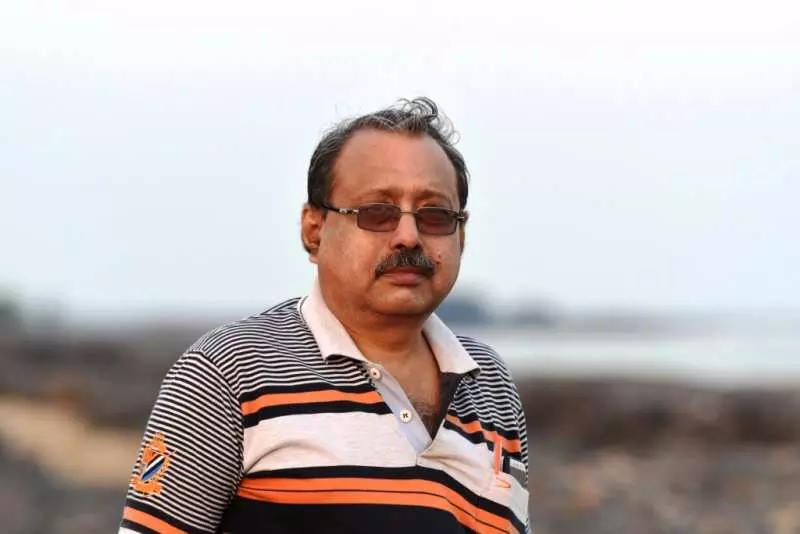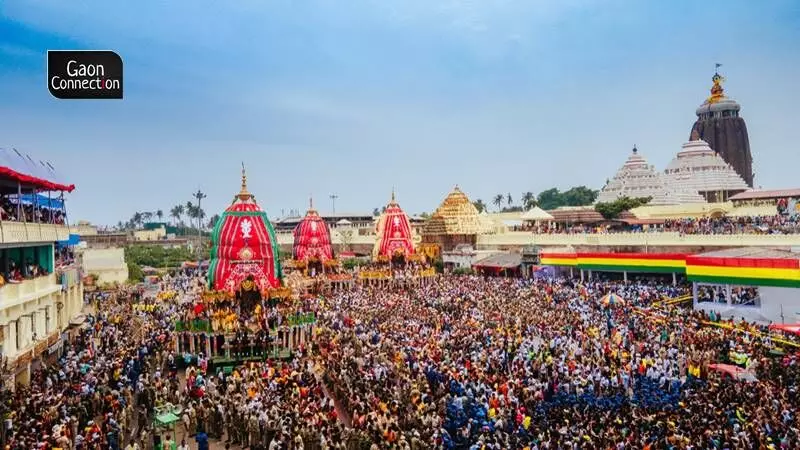Odisha: More than a million revellers throng Puri as Rath Yatra festivities begin in full swing
For the past two years, the Jagannath Yatra in Odisha had been a low-key affair as the general public was not allowed to participate in the grand event in the wake of the COVID-19 pandemic. However, with no restrictions on the event this year, the festivities began today with the riveting pomp and show for which the Jagannath Yatra is known for. Details here.
 Ashis Senapati 1 July 2022 12:52 PM GMT
Ashis Senapati 1 July 2022 12:52 PM GMT

Rath Yatra is the celebration of Lord Jagannath’s journey to his maternal aunt's house near Saradha Bali in Puri along with his elder brother Balabhadra and sister Subhadra. All photos by Jagannath temple office.
The nine-day long Rath Yatra of the famous Jagannath temple in Odisha's Puri commenced today, on July 1, with more than a million visitors attending the procession laden with great fanfare and enthusiasm. For the last two years, the Rath Yatra was observed under strict restrictions in a bid to contain the COVID-19 outbreak and the public wasn't allowed to participate.
The Rath Yatra is an annual affair which commences on the Dwitiya Tithi of the Shukla Paksha in Ashadha month of the Hindu calendar.
Waves of devotees were seen gathered along the route leading to the Jagannath Temple in the coastal town of Puri to witness the nine-day journey of Lord Jagannath, elder brother Lord Balabhadra and sister Devi Subhadra riding on the three decorated chariots.
"The three chariots were tugged by the devotees after the titular king of Puri, Raja Dibyasingha Deb, carried out the 'Chhera Panhara' — a ritual which involves sweeping of the chariots," Samarth Verma, the collector of Puri told Gaon Connection.
Moments after devotees began pulling the ropes, Lord Balabhadra's chariot named 'Taladhwaja' rolled first amidst a symphony of chants, conches and gongs, followed by the rolling of the wheels of 'Darpadalana' — the chariot of Devi Subhadra and Lord Jagannath's chariot, 'Nandighosh' was the last one to move. The three chariots were dragged for three kilometres to Mausima temple which is situated midway along the Bada danda (the grand road) of Puri.
The Rath Yatra is an annual affair which commences on the Dwitiya Tithi of the Shukla Paksha in Ashadha month of the Hindu calendar.
Millions of devotees in the coastal state as well as several other parts of the country glued to their television as Doordarshan broadcast the live proceedings of the Rath Yatra.
Rath Yatra is the celebration of Lord Jagannath's journey to his maternal aunt's house near Saradha Bali in Puri along with his elder brother Balabhadra and sister Subhadra. Lord Jagannath is believed to be the Lord of the universe.
As per the Hindu mythology, once Goddess Lakshmi Devi left the Jagannath Temple thereby Lord Jagannath and Balabhadra became poor and had to go out begging.
When Jagannath and Balabhadra were out, Subhadra Devi was staying with her mausi maa (maternal aunt). The mausi maa is also termed as Ardhashosini. It has been mentioned in the Vaishnava Kanda of the Skanda Purana that Goddess Ardhashosini drank half of the sea water which had flooded Puri and saved the abode of Lord Jagannath.
Waves of devotees were seen gathered along the route leading to the Jagannath Temple in the coastal town of Puri to witness the nine-day journey of Lord Jagannath, elder brother Lord Balabhadra and sister Devi Subhadra riding on the three decorated chariots.
"Goddess Ardhashosini with Kapalamochana Shiva, acts as the guardians of the Shree Kshetra. During the return journey (Bahuda yatra) of Ratha yatra festival, the chariot of Shri Jagannath stops at Mausi Maa temple and the deity is offered with their favourite Poda Pitha, a kind of baked cake made in lentils and rice," said Basudev Das a noted researcher and member of Odisha Sahitya Academy, told Gaon Connection.
Earlier, elephants were used for pulling the chariots in Puri till 1969 . The practice was stopped after an elephant went berserk and trampled a devotee, Das informed.
Traditional Odia dance performances adorn the event
Artists performed the two Odia dance forms — Gotipua and Odissi in front of the 'Pahandi' which is the ceremonial procession of the deities at the sanctum sanctorum of the temple.
Gotipua is a traditional dance form in Odisha and it serves as a vital precursor to the more popular Odissi classical dance.
For the last two years, the Rath Yatra was observed under strict restrictions in a bid to contain the COVID-19 outbreak and the public wasn't allowed to participate.
It has been performed in the state for centuries by young boys who dress as women to praise Lord Jagannath and Krishna. These boys perform the highly acrobatic dance which is inspired by the legendary lives of Radha and Krishna. In the Odia language, Gotipua translates as a 'single boy'.
Nowadays, the Ratha Yatra has become a common sight in most of the major cities across the world since 1968 due to its promotion by the ISKCON's [International Society for Krishna Consciousness] Hare Krishna movement.
rath yatra #Odisha Jagannath Yatra
More Stories




